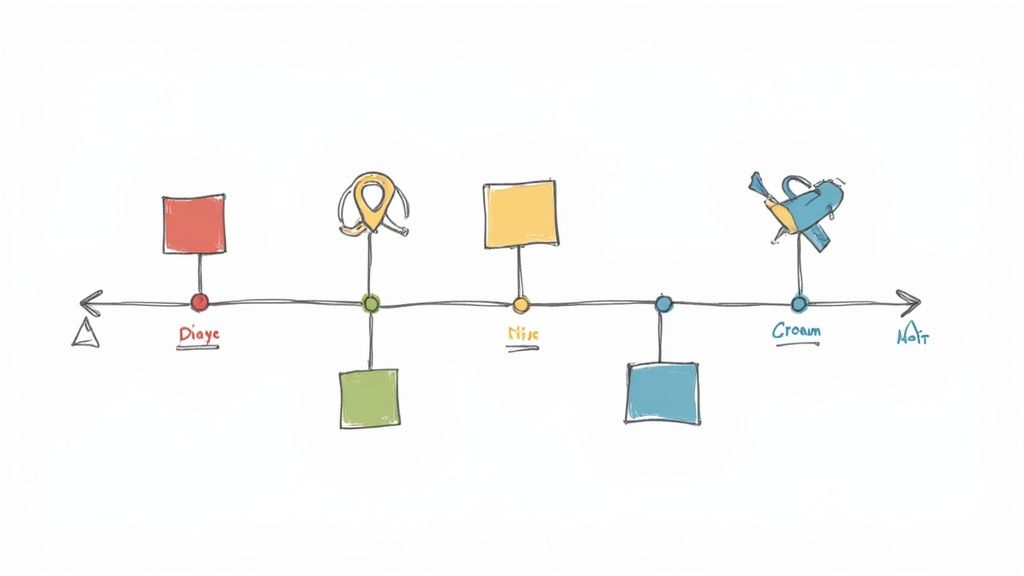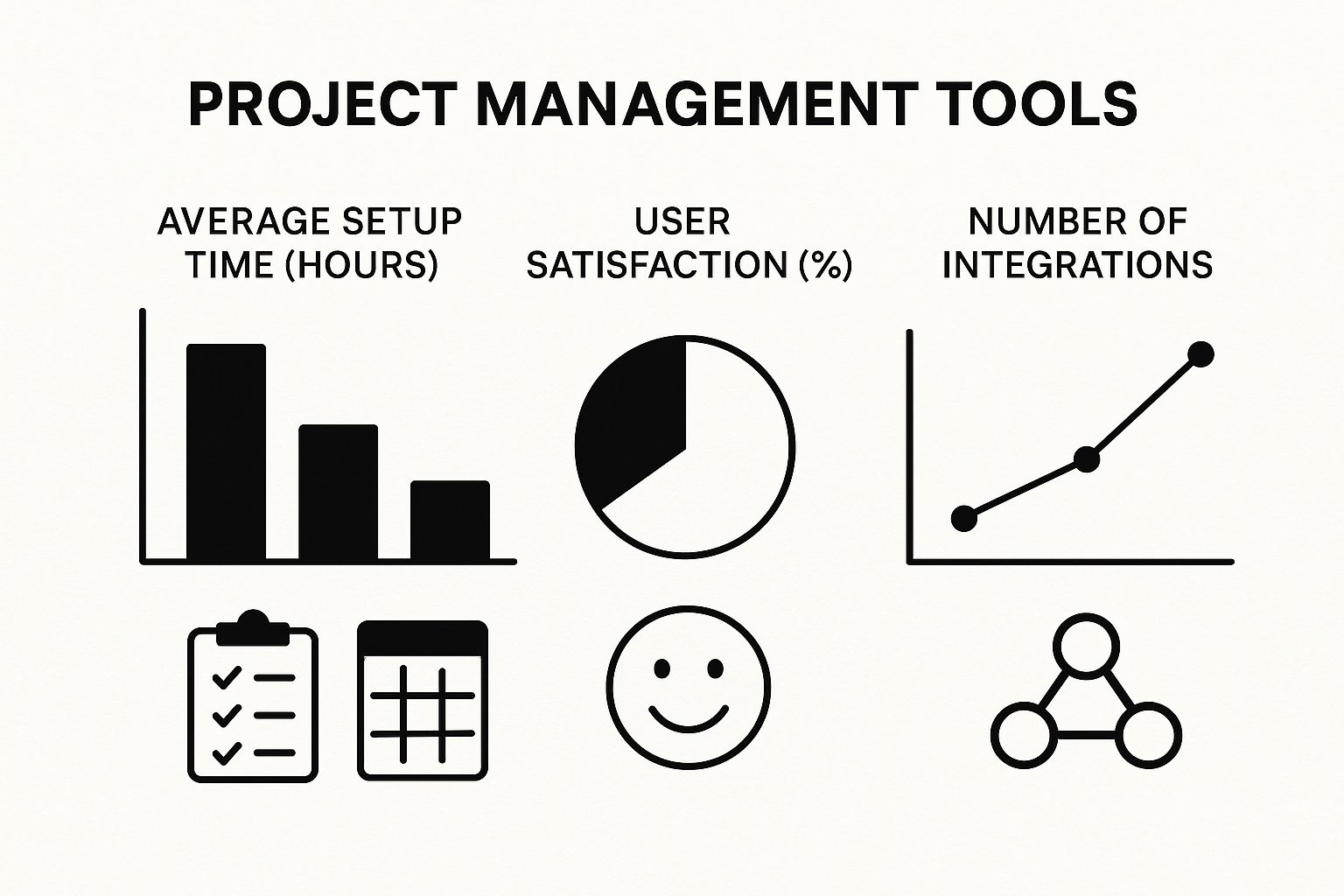Web Dev Project Management Tips to Boost Success
- shems sheikh
- May 27
- 11 min read
The True Cost Of Web Dev Project Management Failures
Web development projects are complex. They involve many stakeholders, intricate technical requirements, and ever-changing client expectations. Successfully managing this complexity requires robust web dev project management. Unfortunately, many projects suffer from preventable management failures, leading to significant financial losses. These failures show up as missed deadlines, budget overruns, compromised product quality, and strained client relationships.
One common problem is poor planning. Without a clear roadmap outlining the project scope, timelines, and resources, teams often struggle to keep up, leading to inefficiencies and wasted resources. This lack of direction can also contribute to scope creep, where the project's requirements grow beyond the initial agreement, further adding to delays and budget problems.
Another major issue is communication breakdown. When developers, designers, clients, and other stakeholders don't communicate effectively, misunderstandings arise. This leads to rework, frustration, and ultimately, financial losses. For example, misinterpreting design specifications could result in developers building the wrong feature, requiring costly revisions.
These failures have a real financial impact. Nearly 10% of every dollar is wasted due to poor project performance, highlighting the need for effective management strategies. Organizations also waste 12% of their resources due to inadequate project management practices. This underscores the importance of sound web dev project management. For more detailed statistics, check out this resource: Learn more about project management statistics
Hidden Costs Beyond the Budget
Beyond the obvious costs like budget overruns and missed deadlines, web dev project management failures create other hidden expenses. These can be even more damaging long-term. One such cost is developer burnout. Constant pressure to meet unrealistic deadlines and fix preventable errors leads to stress, reduced productivity, and eventually, employee turnover. Replacing experienced developers is both expensive and disruptive to project continuity.
Damaged Client Relationships
Another hidden cost is damage to client relationships. When projects are consistently delayed or don't meet expectations, client trust erodes. This can lead to lost contracts and negative reviews, severely impacting an agency's reputation and future business.
Legal disputes can also arise from unmet contractual obligations, adding another layer of financial burden. These repercussions demonstrate that the true cost of web dev project management failures goes far beyond the immediate project budget.
A proactive and strategic approach to project management is crucial. This ensures projects are delivered on time, within budget, and to the client's satisfaction. This approach not only protects financial resources but also builds strong client relationships and safeguards the agency's reputation.
Modern Agile Approaches That Actually Work
Forget rigid waterfall methodologies. Today's web development project management thrives on hybrid agile approaches. These approaches blend core agile principles with practical strategies to handle the unique challenges of web development, such as rapid iteration cycles and detailed client feedback.
Adapting Agile for the Web
Agile isn't a one-size-fits-all solution. Successful web development teams adapt agile to their specific needs. Sprint planning, for example, becomes a dynamic process, incorporating client feedback and adjusting to evolving project scopes.
Daily stand-ups shift from simple status updates to collaborative problem-solving sessions, addressing roadblocks in real-time. Retrospectives become valuable opportunities for continuous improvement, analyzing both successes and failures to refine future sprints.
This adaptability allows teams to balance agile flexibility with client expectations and budget constraints. It also allows for variations based on the team's size and project type. Choosing the right variation is key to realizing agile’s full potential.
For example, smaller teams might benefit from the streamlined approach of Kanban, while larger, more complex projects could find success with Scrum.
The Rise of Hybrid Agile
The trend towards hybrid approaches is gaining momentum. A purely agile approach isn't always the best fit for complex web development projects. In fact, approximately 50% of project teams using agile methodologies combine it with other tools. This signifies a shift towards hybrid project management. Find more detailed statistics here
This hybrid approach allows teams to customize their processes, picking and choosing the aspects of different agile methodologies that best suit their particular situation.
Practical Strategies for Implementation
Successfully implementing agile web development project management requires practical strategies. This includes clearly defined roles and responsibilities within the team, regular communication and feedback loops, and a culture of collaboration and transparency.
Effective sprint planning, with clearly defined goals and deliverables, lays the foundation for a successful project. Daily stand-ups, focused on problem-solving and progress updates, keep the team aligned and on track.
Regular retrospectives, where teams analyze their performance and identify areas for improvement, ensure continuous growth and efficiency. Understanding the reasons behind project failures often starts with recognizing the impact of stress on the team, so consider strategies for workplace stress management. You might also be interested in: How to master design team project management

Essential Tools That Transform Development Teams
Effective web development project management depends on using the right tools. The sheer number of project management software options can feel overwhelming. This section helps you cut through the noise and focus on tools that genuinely improve team collaboration and project delivery. These tools range from task management platforms with seamless development workflow integration to communication tools that keep everyone on the same page. This leads to a crucial question: which tools are worth the investment, and which could hinder your progress?
Key Features to Consider
When evaluating project management tools for web development, prioritize features supporting development workflows. This includes robust code repository integration. Connecting your project management tool with platforms like GitHub allows for streamlined tracking of code changes, bug fixes, and overall progress. Effective client collaboration capabilities are also critical. Look for tools that enable clear communication with clients, making it easy to gather feedback, manage approvals, and share information seamlessly.
Finally, don't underestimate the importance of insightful reporting functionality. This feature provides valuable data on project timelines, budgets, and resource allocation, enabling data-driven decisions.
Evaluating Tools Based on Your Needs
Choosing the right tools means considering factors specific to your team. Team size, project complexity, and budget constraints play significant roles in determining the ideal fit. For smaller teams with less complex projects, a lightweight tool with basic features might be sufficient. However, larger teams handling complex web development projects need more robust solutions with advanced features and scalability. Budget is also key, with options from free open-source tools to premium enterprise platforms.
To help illustrate the differences between popular tools, let's take a look at the following comparison:
To help you compare different options, we've put together a quick overview of a few popular tools:
Web Development Project Management Tools Comparison: A comprehensive comparison of popular project management tools specifically for web development teams, including features, pricing, and best use cases.
Tool Name | Best For | Key Features | Pricing Model | Integration Capabilities |
|---|---|---|---|---|
Small to medium-sized teams | Task management, collaboration, project timelines | Free and paid plans | Integrates with Slack, Google Calendar, and others | |
Visual project management, Kanban boards | Card-based system, customizable workflows, collaboration features | Free and paid plans | Integrates with various tools including Slack and Google Drive | |
Agile development teams, bug tracking | Issue tracking, sprint planning, customizable workflows | Free and paid plans | Extensive integration options, including development tools like Bitbucket |
This table highlights some key differences in features and pricing models, allowing you to quickly identify potential candidates based on your specific needs. Remember to consider your team's workflow and preferred project management style when making your decision.
The infographic below visualizes the average setup time, user satisfaction, and number of integrations for three popular project management tools:

As we can see, Tool B offers a good balance of quick setup, high user satisfaction, and a solid number of integrations, making it a strong contender for many development teams. The increasing use of project management software highlights the importance of these tools in optimizing workflows and promoting collaboration. In fact, 82% of companies use work and project management software to improve organizational efficiency. Explore this topic further
Implementation Strategies for Success
Successfully implementing new tools requires a strategic approach. A phased rollout, starting with a pilot group, can smooth the transition and allow for early feedback. Comprehensive training and ongoing support are essential for team-wide adoption and maximizing the tool's benefits. For efficient project execution, consider a GitHub checklist for project success.
Building Communication Frameworks That Prevent Disasters
Communication is the cornerstone of successful web development project management. When communication breaks down, even the most carefully planned projects can quickly unravel. This section explores how top-performing teams organize their communication to maintain momentum and ensure everyone stays aligned.
Client Communication: Setting the Stage for Success
Effective client communication begins with the very first interaction. Initial discovery calls should not only gather requirements but also set clear expectations for the project's scope, timeline, and budget. This proactive approach establishes a collaborative and transparent partnership. For instance, clearly outlining the project deliverables and milestones in a shared document keeps everyone on the same page from the start.

Additionally, scheduling regular check-in points throughout the project lifecycle allows opportunities for feedback and adjustments. These check-ins can vary, from weekly status updates to live demos of the developing product. This consistent communication builds trust and allows for course correction before small issues become major problems.
Managing Scope Creep Through Strategic Communication
Scope creep, the expansion of a project beyond its initial parameters, is a common challenge in web development. However, strategic communication makes managing scope creep much easier. This involves promptly addressing any changes in requirements with the client and discussing their impact on the project timeline and budget. This transparency allows clients to make informed decisions about prioritizing features and managing their expectations.
Effective communication frameworks can significantly reduce project failures and boost team efficiency. Structured communication processes are essential for keeping stakeholders aligned throughout the development lifecycle. For more detailed information, see this study: Learn more about communication frameworks.
Internal Team Communication: The Engine of Collaboration
While client communication is crucial, internal team communication is equally important. Regular project meetings should be focused and action-oriented, offering a platform for problem-solving and decision-making. Documenting these decisions in a central location, such as a shared project management tool like Notion, prevents confusion and ensures everyone works with the same information. For remote teams, these communication practices are especially important. For some helpful tips check out: Top remote team communication tips to boost collaboration
Knowledge Transfer and Project Continuity
Ensuring knowledge transfer within the team is vital for long-term project success. This becomes particularly critical when team members change roles or leave the project. Proper documentation and knowledge-sharing practices protect the project from disruptions and ensure its continuity. Using a checklist can help maintain organization and efficiency. One useful resource is a GitHub checklist for project success. These frameworks help build a cohesive and productive team dynamic, which is essential for delivering successful web development projects.
Risk Management Strategies That Actually Protect Projects
After setting up clear communication, the next big step in managing web development projects is handling potential risks. Every project, from small updates to complex builds, faces risks. These risks can throw off timelines, blow budgets, and even hurt team morale. The key is to be prepared and manage those risks effectively.
Identifying and Assessing Common Risks
The first step is spotting potential problems. This means brainstorming everything that could go wrong. These risks could be technical, like browser compatibility issues or unexpected bugs. They could also be business-related, such as changing client needs or market shifts.
Once you've identified the risks, you need to figure out how likely they are to happen and how bad the impact would be. A risk assessment matrix can help you visualize this. You can rate each risk as low, medium, or high. This helps you see which risks are the biggest threats to your project's success.
Developing Mitigation Strategies
Once you understand the risks, it's time to develop mitigation strategies. These strategies are specific actions you can take to either prevent a risk from happening or lessen its impact if it does. For example, to avoid browser compatibility issues, your strategy could involve thorough cross-browser testing throughout development.
Building Contingency Plans
Even the best plans can go sideways. That's where contingency plans come in. These are backup plans for when things go wrong, even if you've tried to prevent them. Contingency plans help you keep moving forward when the unexpected happens.
For example, if a key team member suddenly becomes unavailable, your contingency plan might involve reassigning tasks or hiring a temporary contractor. Being prepared is crucial for project success. Studies show that proactive risk management can reduce project failure rates by up to 60%. Teams that use structured risk assessment also have fewer budget overruns and delays. Want to learn more? Read the full research here
Quality Assurance and Testing
A major part of risk management in web development involves strong quality assurance (QA) and testing. These processes find and fix defects early in development, stopping them from becoming bigger, more expensive problems down the line.
A good QA framework includes regular code reviews, automated testing, and user acceptance testing (UAT). These steps ensure the final product meets the client's needs and works as expected across different platforms and devices. Your testing should cover everything from functionality and performance to security and usability. This thorough approach helps reduce technical risks and makes for a smoother launch. Want more tips for managing remote teams? How to master project management for remote teams
Common Web Development Project Risks and Mitigation Strategies
To help illustrate how to manage risks, let's look at a table outlining some common risks, their potential impact, and strategies for preventing and mitigating them.
Risk Category | Probability | Impact Level | Prevention Strategy | Mitigation Plan |
|---|---|---|---|---|
Browser Compatibility Issues | Medium | High | Cross-browser testing during development | Implement fallback solutions for older browsers |
Shifting Client Requirements | High | Medium | Clearly defined scope and change management process | Regular communication and flexible project planning |
Key Team Member Unavailability | Low | High | Cross-training team members | Contingency staffing plan and knowledge documentation |
This table shows how planning ahead can help you avoid major problems. By thinking through potential risks and developing clear strategies, you can keep your projects on track.
By proactively identifying, assessing, and mitigating risks, development teams create more resilient projects. This careful planning helps avoid costly rework, stay on schedule, and build strong client relationships.
Measuring Success and Driving Continuous Improvement

Successfully managing a web development project relies heavily on accurately measuring its success. Many teams, however, focus on superficial metrics instead of those that truly reflect project health and predict positive outcomes. This section will explore the Key Performance Indicators (KPIs) that actually matter.
Identifying the Right KPIs for Web Dev Projects
We'll look at both quantitative and qualitative measurements. Quantitative metrics, such as timeline adherence and budget variance, provide concrete data about project progress. Tracking how well the project sticks to its schedule, for example, allows for early identification of potential delays.
Budget monitoring throughout the project lifecycle is equally important for highlighting any cost overruns. However, numbers don't tell the whole story.
Qualitative measures, like client satisfaction scores and team morale indicators, offer valuable insights into the project's overall health. High client satisfaction often leads to repeat business and valuable referrals.
A motivated team is naturally more productive and delivers higher quality work. This means finding the right balance between quantitative and qualitative KPIs is essential for effective web development project management.
Building Effective Dashboards for Project Visibility
Tracking KPIs is only beneficial if the data is easily accessible and understandable. This highlights the importance of project dashboards. These dashboards should offer real-time visibility into project progress without overwhelming the team with too much information.
A well-designed dashboard emphasizes the most critical KPIs, enabling quick identification of potential issues. This timely visibility allows for proactive intervention and course correction, keeping the project on the right path. For example, if the dashboard reveals a significant budget deviation, the team can quickly investigate the cause and take corrective action.
Using Data to Drive Informed Decisions
Dashboards are more than just reporting tools; they empower informed decision-making at every project stage. They provide the necessary data to guide choices throughout the web development process.
Data on task completion rates, for instance, can inform resource allocation for future sprints. Client feedback from surveys can also guide design iterations and feature prioritization. This data-driven approach ensures that decisions align with project goals and client expectations.
Post-Project Reviews and Continuous Improvement
A project doesn't simply end with delivery. Post-project reviews are essential for continuous improvement. These reviews provide a valuable opportunity to reflect on successes, areas for improvement, and lessons learned for future projects.
Capturing these actionable lessons learned is crucial for making each subsequent project more efficient and profitable. This continuous feedback loop enables teams to refine their processes and consistently elevate their performance.
For a seamless and efficient way to manage feedback and tasks throughout your web dev projects, consider Beep. Beep is a feedback and collaboration platform that allows you to add comments directly to live websites, automatically capturing screenshots with each annotation. This visual feedback method ensures clear communication and faster iterations. With its built-in Kanban board and integrations with popular tools like Slack, Zapier, Jira, Notion, and more, Beep helps teams streamline workflows and enhance productivity. Learn more about how Beep can transform your web dev project management.

.png)
Comments